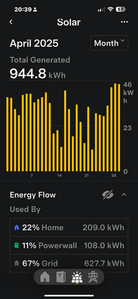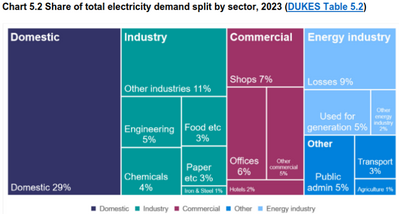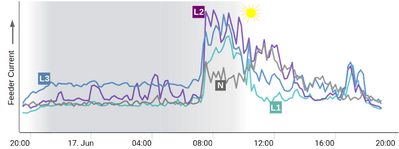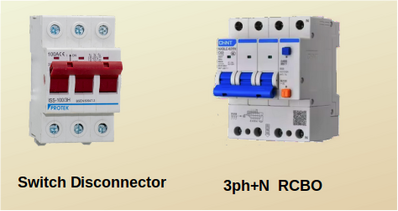@andris This April was better than the previous two Aprils have been! Exporting on Intelligent Octopus Flux which provides a little over 22 pence per kWh and nearly 30 pence between 16:00 and 19:00. Regards, Toodles the Scrooge.
Toodles, heats his home with cold draughts and cooks food with magnets.
Posted by: @andrisdecided aginst it as I felt with tarrifs getting better for export let them store my energy [...]
Now that NESO and the RESPs are directing future electricity strategy, there will be a much greater emphasis on the physics underlying the principles of single-phase export from domestic properties.
Evaluating the benefits of grid-export using (Ofgem-approved) tariffs doesn't reflect what's happening.
Although domestic consumption accounts for less than 30% of the total, it is the single major contributor to the 9% losses within the electricity supply chain.
See DUKES 2023 stats, as published in July'24.
Losses at local substations due to phase imbalance are unsustainable.
It's not just the heat which is created in the transformer, but also damage to underground cables from high-currents in the Neutral return path.
Here's a timeline showing current flows on just one feed (out of four) from a local substation:
There's mist/fog in the air until 10:30 when sunshine breaks through.
Homes supplied by phase-L1 have more solar generation than the others, which is reflected in less power being drawn from the grid.
As a direct consequence, current in the Neutral rises, and energy is dissipated as heat into the cooling oil surrounding the transformer.
We can't attain Net Zero with the local distribution grid under such stress.
Export tariffs must change to reflect best practice.
DUKES is the Digest of UK Energy Statistics, published annually in July for preceding calendar year.
Chapter 5 covers electricity supplies.
Save energy... recycle electrons!
@transparent What (if anything)can we as domestic consumers / producers do to alleviate the situation? Are there strategies we might adopt to reduce the strain please?
I am assuming that by allowing Octopus Energy some control over my battery and when this charges via grid and or solar and when they discharge the battery as export to the grid, Octopus are helping the DNO’s in their endeavours - but are they? Regards, Toodles.
Toodles, heats his home with cold draughts and cooks food with magnets.
@transparent so what is the best way forward? It seems sensible to have distributed generation and local battery storage - if you can afford it - to help ameliorate issues similar to those a few days ago in Iberia.
If I had a 3-phase supply, I suppose I would need to change to a 3-phase ASHP and EV charger, but what about my other single-phase appliances? Do they get connected to one of the phases or can you get a converter so that the single phase load is somehow shared across the 3-phase supply?
And I suppose I would need a 3-phase inverter as well for the solar panels?
Mitsubishi Zubadan 14kW with Mixergy 210l DHW in 220m2 barn property. 24 solar panels = 9kWp with GivEnergy 5.0kW Hybrid inverter and 19kWh GivE batteries. Jaga Strada fan-assisted rads throughout. Landvac vacuum glazing/triple glazed windows.
I did ~490kWh in April from my south facing 4kW system in rural Worcestershire. Very pleased. That paid ~£360 via FiT.
ASHP is currently switched off (infinite CoP?) 🤔 as h/w heater via electric diverter from solar PV
Daikin Altherma 3H HT 12kWh ASHP with Mixergy h/w cylinder; 4kW solar PV with Solic 200 electric diverter; Honda e and Volvo EX30 Ultra Twin Performance electric vehicles with Myenergi Zappi mk1 & Ohme chargers
Yes. Storing the solar generation within the home is greatly preferable.
NESO calls that approach "meter side" (meaning 'on the consumer side of the meter').
Yes, we need more homes on 3-phase supplies, and the DNO would normally make this a requirement if an application for a Heat-Pump or EV-charger indicated at household consumption was 60A or above (ignoring short-term surges of course).
Migrating to 3-phase should ideally be done
- before installing a heat pump, because 3ph compressors & pumps are inherently more efficient
- before installing an EV charger, because a 3ph unit can deliver 11kW rather than 7kW
So we need to draw the attention of householders to these factors before they consider such equipment.
That means having such conversations in pubs and social events.
Ideally we need a much larger public-awareness campaign with local energy seminars... but there's no incentive for the energy industry to fund it.
Having a 3-ph supply and Smart Meter does not mean that you must have an industrial-looking 3-ph consumer unit!
Only the 3ph appliances need connections from a 3ph distribution board.
A standard consumer unit can be fitted with a 3ph Switch Disconnector and 3ph trips for just those devices.
If we want to further explore 3-phase stuff, can we please start a fresh topic which others can find.
I have much more I could say, but it's not relevant to this topic title.
And no @toodles - Octopus are unable to provide any grid-friendly battery storage operation for you.
There's no monitoring apparatus on the 11kV and 240/415v levels of the grid which they can access, even if they wanted to.
The LV diagrams I'm posting here are extremely rare.
Not only am I unaware of anyone else handling/investigating such data,
but I also have my own grid monitors 'in the field'.
I have not (yet) posted data from my monitors here on the Forum.
Save energy... recycle electrons!
@julianc I don't have the fit payments like you, but it seems amazing. Would you rather not have your heatpump make the hot water even if the cop is only 2.5. As u are using the immersion heater you cop is 1. It sounds to me itnm is relly good deal for you to sell the electricity, but if u use up what u make with one kw in one kw out u use a lot more even if the energy come from the grid some from solar. This way u can sell more. I hope that make sense?Andris
16kw Samsung TDM ASHP. 8.4kw PV, power optimizers 20×420watt panels 6kw SolarEdge inverter.
We are way up north, so get anywhere near the same output and we have lots of tree shading, but our April output was better than any previous years.
We don't get paid for export, so try to use every kWh we produce. In March we paid almost nothing for heating, use a simple script in home assistant to drive a relay, based on battery charge percentage and PV generation. This moved the heat pump to second operating point, which means it runs for as many hours as called for. So most excess PV got converted by a CoP of around 4 to 5 into heat buffered into our concrete floor.
So by the end of the solar day, on a good day, battery was nearly full, house heat satisfied and cylinder at 70 degs via immersion. Plus any clothes washing, plus drying and dishwasher all done.
@andris hi. Whilst I understand your logic, the FiT is a generation payment. So I generate 50kWh. I get paid for 50kWh. It assumes I use 50% of those kWh and the rest are passed to the grid. To be used by neighbours or whomever.
I turn off our hp in the summer. Better than having the thing start and stop unnecessarily. But it would be more efficient using the ASHP. As you suggest.
Daikin Altherma 3H HT 12kWh ASHP with Mixergy h/w cylinder; 4kW solar PV with Solic 200 electric diverter; Honda e and Volvo EX30 Ultra Twin Performance electric vehicles with Myenergi Zappi mk1 & Ohme chargers
April 2025 production: 795 kWh (ranking as our second-best April performance).
Get a copy of The Ultimate Guide to Heat Pumps
Subscribe and follow our YouTube channel!
Posted by: @juliancThat paid ~£360 via FiT.
You’re on an insane FiT rate 😂 I don’t think we get that in a year. 😤
Get a copy of The Ultimate Guide to Heat Pumps
Subscribe and follow our YouTube channel!
@editor FIT rate is determined by OFGEN, for a typical 2-4kW home system installed in 2010 on medium tariff, yes it’s that complex to work out your kWh rate, you get paid 23pkWh wether you export anything or use it all yourself running heaters, out door spa.
The FIT payments are another reason everyone else is paying over the top for electricity as these are divided out over those not on FIT
OFGEN doesn't publish how much money they pay out each quarter for the scheme, and when it will eventually end, but if JulianC is paid £360, assuming there are 10000 homes doing the same. Thats £3.6million/quarter everyone is paying, and there is no requirement or metering of export electricity so if no-one exported a kWh, then were all paying a lot of money for no extra power.
only a politician could dream up a scheme where you pay for nothing
-
Plug and play solar. Thoughts?
5 months ago
-
Supplier choices for PV system
2 years ago
-
Any advice for new solar installation? SW facing extension
2 years ago
-
First 6 months
3 years ago
Currently viewing this topic 1 guest.
- 26 Forums
- 2,342 Topics
- 53 K Posts
- 343 Online
- 6,000 Members
Join Us!
Worth Watching
Latest Posts
-

RE: Are We Sleepwalking Into Another Race to the Bottom?
…otherwise known as “hive got news for you”. And don’...
By Majordennisbloodnok , 8 hours ago
-
RE: Configuring third party dongle for Ecodan local control
Logically, I'll fall into that category so the natural ...
By Sheriff Fatman , 9 hours ago
-

RE: Controlling Daikin Altherma via P1P2 and Home Assistant
I haven’t got a Daikin but I have been having some fun ...
By Majordennisbloodnok , 9 hours ago
-

RE: Setback savings - fact or fiction?
@robs — thanks again for your detailed comments. Some r...
By cathodeRay , 11 hours ago
-
RE: Free Ecoheat Heat Pump Install
I don't mind thread drift, it's how conversation natura...
By Deltona , 13 hours ago
-

RE: A Smarter Smart Controller from Homely?
@papahuhu I hope you get a swift resolution. Regards, T...
By Toodles , 15 hours ago
-

RE: Poll for Time of Use, tariffs, technology
That’s fine by me too Major, I feel it is a sad reflect...
By Toodles , 17 hours ago
-

Bingo. Sometimes a judiciously placed size 10 bovver bo...
By Majordennisbloodnok , 17 hours ago
-
RE: Mitsubishi Ecodan 11.2kW heat pump with low COP
@ciocoiu-alexandru I can't provide the same level of di...
By Sheriff Fatman , 17 hours ago
-
RE: Octopus Cosy Heat Pump Owners & Discussion Thread
Recently had my follow up with octopus for the vibratio...
By swwils , 19 hours ago
-

The three technical issues I'm considering are: BMS...
By Transparent , 19 hours ago
-
RE: LiFePO4 lithium battery fires and explosions
@transparent Your post may fit better in th...
By Batpred , 20 hours ago
-

RE: British Gas vs Octopus Energy vs Heat Geek vs EDF vs Aira vs OVO vs EON.Next vs Boxt
@jamespawhite, if you could be bothered, you could also...
By Mars , 22 hours ago
-
RE: Commencing on an ASHP Installation Process
I've got a bit of time to draft something today, so the...
By Sheriff Fatman , 2 days ago
-
RE: Help with heat pump sizing
@amin I dont think materially relative to t...
By JamesPa , 2 days ago
-

@majordennisbloodnok I have decided to take the plunge....
By TechnoGeek , 2 days ago
-
RE: Different dT on each radiator?
I cant sorry. Its based on some calculations I did fro...
By JamesPa , 2 days ago
-
RE: Help me keep the faith with my air source heat pump installation
@simonf thats interesting as I’ve noticed my flow and r...
By AdamK , 3 days ago









